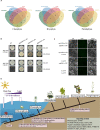Origin and adaptive evolution of UV RESISTANCE LOCUS 8-mediated signaling during plant terrestrialization
- PMID: 34662425
- PMCID: PMC8774840
- DOI: 10.1093/plphys/kiab486
Origin and adaptive evolution of UV RESISTANCE LOCUS 8-mediated signaling during plant terrestrialization
Abstract
UV RESISTANCE LOCUS 8 (UVR8) mediates photomorphogenic responses and acclimation to UV-B radiation by regulating the transcription of a series of transcription factors (TFs). However, the origin and evolution of UVR8-mediated signaling pathways remain largely unknown. In this study, we investigated the origin and evolution of the major components of the UVR8-mediated signaling pathway (UVR8, REPRESSOR OF UV-B PHOTOMORPHOGENESIS [RUP], BRI1-EMS-SUPPRESSOR1 [BES1], BES1-INTERACTING MYC-LIKE 1 (BIM1), WRKY DNA-BINDING PROTEIN 36 (WRKY36), MYB DOMAIN PROTEIN 73/77/13 [MYB73/MYB77/MYB13], and PHYTOCHROME INTERACTING FACTOR 4/5 [PIF4 and PIF5]) using comparative genomics and phylogenetic approaches. We showed that the central regulator UVR8 presented a conservative evolutionary route during plant evolution, and the evolutionary history of downstream negative regulators and TFs was different from that of green plant phylogeny. The canonical UVR8-CONSTITUTIVELY PHOTOMORPHOGENIC 1(COP1)/SUPPRESSOR OF PHYA-105 (SPA)-ELONGATED HYPOCOTYL 5 (HY5)-RUP signaling pathway originated in chlorophytes and conferred green algae the additional ability to cope with UV-B radiation. Moreover, the emergence of multiple UVR8-mediated signaling pathways in charophytes laid the foundations for the cross-talk between UV-B signals and endogenous hormone responses. Importantly, we observed signatures that reflect plant adaptations to high UV-B irradiance in subaerial/terrestrial environments, including positive selection in UVR8 and RUPs and increased copy number of some vital TFs. These results revealed that green plants not only experienced adaptive modifications in the canonical UVR8-COP1/SPA-HY5-RUP signaling pathway, but also diversified their UV-B signal transduction mechanisms through increasing cross-talk with other pathways, such as those associated with brassinosteroids and auxin. This study greatly expands our understanding of molecular evolution and adaptive mechanisms underlying plant UV-B acclimation.
© American Society of Plant Biologists 2021. All rights reserved. For permissions, please email: journals.permissions@oup.com.
Figures






References
Publication types
MeSH terms
Substances
LinkOut - more resources
Full Text Sources
Research Materials

